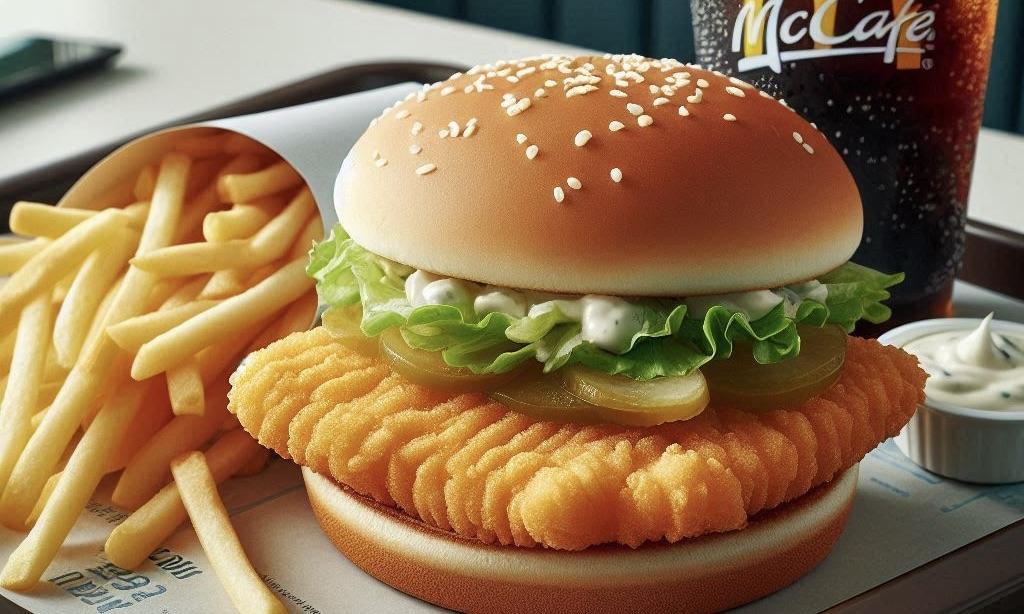McDonald’s Filet-O-Fish sandwich features wild-caught Alaska Pollock, known for its sustainability and mild, flaky texture. The fish is sourced from the waters around Alaska, reflecting the fast-food giant’s commitment to using sustainable ingredients in its iconic sandwich.
McDonald’s Filet-O-Fish Features Sustainable Alaska Pollock, Highlighting a Commitment to Responsible Sourcing
McDonald’s Filet-O-Fish sandwich, beloved by many, is celebrated for its simple yet satisfying combination of crispy white fish, cheese, and a soft bun. The Filet-O-Fish holds a unique appeal even for those who aren’t avid fish sandwich fans. But have you ever wondered what kind of fish is inside? You’re not alone, and the answer is surprisingly good news: McDonald’s not only sources sustainable fish but also uses one of Alaska’s most abundant resources.
The fish in the Filet-O-Fish is Alaska Pollock, wild-caught from the waters around Alaska and the Bering Sea. This choice reflects McDonald’s commitment to sustainability. Alaska Pollock is managed by strict regulations, making it one of the most sustainable fish populations, with minimal risk of overfishing and low bycatch (unintended capture of other species). This ensures that the fish in your sandwich was thriving in the ocean not long before it was cooked and served.
Interestingly, the Filet-O-Fish could have been made with a different type of fish. Originally, McDonald’sconsidered halibut, and for about 50 years, the sandwich was made with cod. However, it features Alaska Pollock, a fish praised not only for its sustainability but also for its nutritional value.
McDonald’s sells an impressive 300 million Filet-O-Fish sandwiches annually. Given this volume, the company’s dedication to using sustainable fish is a significant achievement. In 2013, McDonald’s began displaying the blue fish label of the Marine Stewardship Council (MSC), making it the only national U.S. restaurant to earn this distinction. This certification highlights the responsible practices employed from sea to sandwich.
From Halibut to Pollock: How the Filet-O-Fish Became a Sustainable and Flavorful Favorite
The Filet-O-Fish was created by franchise owner Lou Groen, who sought a meat-free option to attract Cincinnati’s Catholic population during Lent. The sandwich was a hit, saving Groen’s franchise and helping him expand to 43 more locations. While Groen believed his original halibut version was superior to the cod-based Filet-O-Fish that followed, the switch to Alaska Pollock has proven an intelligent choice for sustainability and flavor.
Alaska Pollock, known for its mild taste, flaky texture, and rich omega-3 content, is frozen at sea, ensuring a fresh product when it reaches McDonald’s kitchens. It’s also one of the most popular fish in the U.S., found in the Filet-O-Fish and various other dishes, including Alaska Pollock gratin. This combination of sustainability, flavor, and nutrition makes Alaska Pollock the perfect choice for McDonald’s iconic sandwich.



 Elon Musk Says X Will Open-Source Its Algorithm Amid EU Scrutiny
Elon Musk Says X Will Open-Source Its Algorithm Amid EU Scrutiny  Stellantis to End Plug-In Hybrid Sales in the U.S. as Demand Shifts Toward Traditional Hybrids
Stellantis to End Plug-In Hybrid Sales in the U.S. as Demand Shifts Toward Traditional Hybrids  Nvidia Appoints Former Google Executive Alison Wagonfeld as First Chief Marketing Officer
Nvidia Appoints Former Google Executive Alison Wagonfeld as First Chief Marketing Officer  Britain has almost 1 million young people not in work or education – here’s what evidence shows can change that
Britain has almost 1 million young people not in work or education – here’s what evidence shows can change that  The Beauty Beneath the Expressway: A Journey from Self to Service
The Beauty Beneath the Expressway: A Journey from Self to Service  Allegiant to Acquire Sun Country Airlines in $1.5 Billion Deal to Expand U.S. Leisure Travel Network
Allegiant to Acquire Sun Country Airlines in $1.5 Billion Deal to Expand U.S. Leisure Travel Network  AI is driving down the price of knowledge – universities have to rethink what they offer
AI is driving down the price of knowledge – universities have to rethink what they offer  Canada’s local food system faces major roadblocks without urgent policy changes
Canada’s local food system faces major roadblocks without urgent policy changes  Walmart to Join Nasdaq-100 Index as It Replaces AstraZeneca Following Exchange Move
Walmart to Join Nasdaq-100 Index as It Replaces AstraZeneca Following Exchange Move  Chevron Sees Path to Boost Venezuela Oil Output by 50% After Trump Administration Talks
Chevron Sees Path to Boost Venezuela Oil Output by 50% After Trump Administration Talks  Every generation thinks they had it the toughest, but for Gen Z, they’re probably right
Every generation thinks they had it the toughest, but for Gen Z, they’re probably right  Why have so few atrocities ever been recognised as genocide?
Why have so few atrocities ever been recognised as genocide?  The American mass exodus to Canada amid Trump 2.0 has yet to materialize
The American mass exodus to Canada amid Trump 2.0 has yet to materialize  FTC Blocks Edwards Lifesciences’ JenaValve Acquisition in Major Antitrust Ruling
FTC Blocks Edwards Lifesciences’ JenaValve Acquisition in Major Antitrust Ruling  Trump Pushes $100 Billion U.S. Oil Investment Plan for Venezuela After Maduro Seizure
Trump Pushes $100 Billion U.S. Oil Investment Plan for Venezuela After Maduro Seizure  The pandemic is still disrupting young people’s careers
The pandemic is still disrupting young people’s careers 































